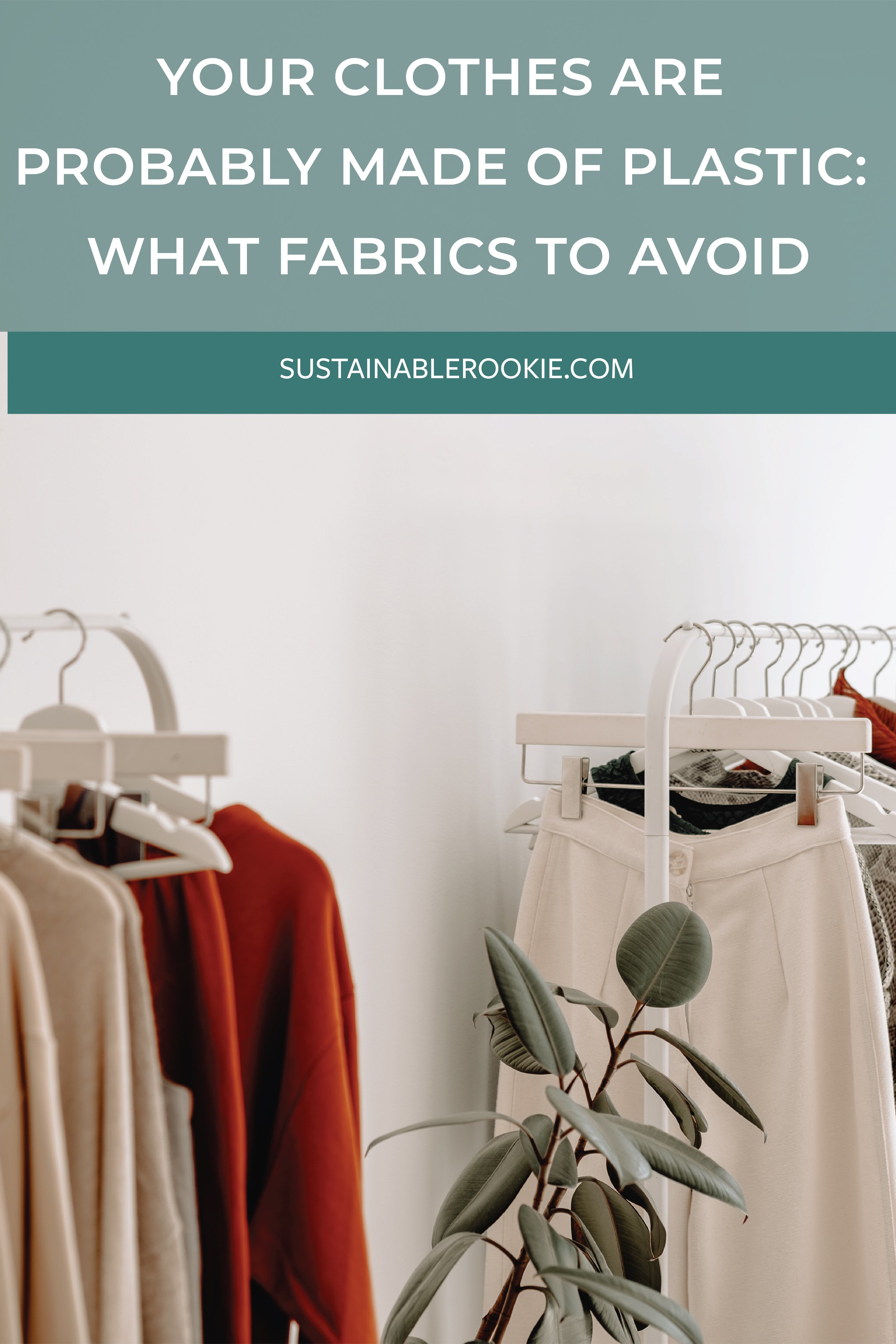Your Clothes Are Probably Made Of Plastic: What Fabrics To Avoid
When trying to live more sustainably, we tend to think about the importance of reducing single-use plastics like straws, plastic bottles and bags. That’s something we should be careful with, particularly because it’s easy to avoid using them if you set your mind to it. However, plastic is hidden in places you might have never thought about. Hold on to your hats: the clothes in your wardrobe are probably made of plastic.
What’s the problem with clothes made of plastic if you recycle them? Well, some companies do recycle it, which is a great way of giving a new purpose to old clothes. Nonetheless, we shouldn’t only focus on what happens to our clothes after their life ends, but also how they’re made and how we take care of them when it’s still in our wardrobe.
Synthetic fabrics are popular because they’re cheap and versatile (they can be used to make winter clothes warm, as well as to provide breathability in sports clothes), but their environmental impact is something that we can’t ignore and that we should consider when buying clothes. There are many reasons why sustainability in fashion is crucial, and choosing eco-friendly fabrics is part of our responsibility as conscious consumers.
WHY ARE FABRICS MADE OF PLASTIC BAD FOR THE ENVIRONMENT?
60% of our clothes are made of plastic. That’s a big number! Approximately 63% of the materials used for clothing are virgin plastics, compared to a 3% of recycled fabrics. To accurately analyze its sustainability, it’s also important to consider the fact that plastic depends on fossil fuel extraction.
Globally, around 100 billion items of clothing are produced each year. EPA estimated that the generation of textiles in 2018 in the United States was 17 million tons, which means approximately 10.2 million tons of clothes made of plastic are produced annually in the U.S. In 2018, EPA recorded 11.3 million tons of textile waste in the U.S, a staggering 7.7% of all municipal solid waste.
These numbers show us that the amount of clothes produced every year is absurd, and most are thrown away and end up in a landfill. Because more than half of them is made of plastic, we can conclude that we have a problem, as plastic doesn’t biodegrade, and it takes years for it to break up.
Another one of the main reasons why the synthetic clothes we use aren’t environmentally friendly, is that washing them pollutes the ocean. When we wash our clothes, abrasion and shedding causes small synthetic fibers to come off, and the filter inside the machines can’t catch them. Thus, they pass through to sewage water, and potentially end up in the ocean, or rivers, as microplastics, which are ingested by marine wildlife and humans (via seafood, or tap water, for instance). Laundry is responsible for a 35% of global releases of primary microplastics to the world oceans.
More than 5 trillion plastic pieces weighing over 250,000 tons afloat at sea, of which 35,500 tons are microplastics. There are more microplastics than straws in the ocean (there are approximately 2,000 tons of straws in the ocean), so putting our sustainability efforts in the fashion industry is imperative.
It’s estimated that by 2025 there will be 1 ton of plastic for every 3 tons of fish in the oceans, and by 2050 the weight of plastic will overtake that of fish. In 2011, the ecologist Mark Anthony Browne was the first to conclude that 85% of the human-made materials discovered on the shorelines were microfibers and matched the types of material used in clothing. He also showed that a single garment might produce over 1,900 fibers per wash.
THE MOST POPULAR SYNTHETIC FABRICS
Polyester, Acrylic, and nylon are some of the most popular synthetic fabrics, which are partly made of plastic. As I mentioned before, they’re a problem in every part of the process, from their production to its usage, to its afterlife.
Acrylic releases an estimated 728,789 fibers from a 6kg wash, and polyester 496,030. A polyester-cotton blend will release almost 138,000. They specifically shed more fibers when they’re brand new and start releasing less (but still a lot) from the second wash onwards.
POLYESTER
Polyester (polyethylene terephthalate) is a synthetic fabric derived from petroleum-based products obtained from fossil fuels, which are non-renewable resources and a big pollutant. To produce plastic-based textiles for the fashion industry, an estimated 342 million barrels of oil are used every year. Polyester accounts for 52% of the overall fiber market, and around 80% of synthetic fibers, thus guilty of encouraging overproduction.
At every stage of its life, it has negative environmental impacts, which we should understand for us to embrace more sustainable fashion choices. To refine crude oil into petroleum and to produce ethylene, a lot of toxic chemicals and heavy metals are released into the environment, polluting the air, water, and land. Also, it requires high amounts of energy and resources–including water–to be produced. In addition, a special type of dye is required to color polyester, which ends up intoxicating animals and plants, and the dye workers. Once the consumer gets their polyester product, microfibers are released into the sewage when washed, and later into the oceans.
Even though polyester garments last many years and are easily washed, they will pollute water during all those years, and they will also last more years than a person can wear it in the landfill. Most polyesters aren’t biodegradable and will decompose in up to 200 years, leaving toxins behind.
ACRYLIC
Acrylic is a synthetic fiber made from polymers formed by acrylonitrile or vinyl cyanide, also produced from fossil fuels. It’s used for warmer clothes because of its heat-retention qualities.
Just as with polyester, its production relies heavily on the petrochemical industry and fossil fuel extraction, and it’s responsible for releasing toxic chemicals into the environment and that are hazardous for factory workers. Acrylic fibers require 40% more energy than polyester. Regarding its polluting attributes during usage, it’s one of the most polluting ones during laundry, as more than 700,000 fibers could be released from an average 6 kg wash load of acrylic fabric.
Acrylic is also not biodegradable, and decomposing could take up to 200 years, and it’s also not recyclable. Another very important matter to have in consideration is that it can be harmful to wear it. The main ingredient in acrylic, acrylonitrile, and can enter the body through skin absorption, inhalation, and ingestion, and cause several symptoms, including headache, nausea, and cancer.
NYLON
Nylon is the third synthetic fabric we will discuss, as it is a type of plastic that derives from crude oil and petroleum–non-renewable energy–and it accounts for about 12% of all synthetic fabrics. A very popular nylon product are tights, and to get that elasticity, the product must be put through intensive chemical processes, that are harmful to the environment. Producing nylon releases nitrous oxide, a greenhouse gas that is 300 times more potent than carbon dioxide in warming the atmosphere, not to mention it requires absurd amounts of resources, mainly water and energy. This fabric is also one of the most energy-consuming ones, using double the amount of energy than polyester to be produced.
Nylon’s production is cheap, and so is their quality, which means it can break easily, and is therefore also not sustainable for that reason. A short lifespan makes a garment unsustainable because it feeds the fast fashion circle and increases the amount of clothes in the landfill, but this material is also not biodegradable. It can take nylon between 30 and 40 years to break up. Because it’s treated with harmful chemicals and dyes, and even bleached, they are harmful for the environment when produced and when disposed of, and means water is polluted during its production. As with polyester and acrylic, nylon releases microplastics to the oceans when it’s washed.
HOW CAN I MAKE MY CLOTHES MORE SUSTAINABLE?
You’re probably wondering what you should do about this. Polyester, acrylic and nylon are made from petrochemicals, so they’re certainly bad for the environment and even for yourself. They pollute the air, the water, they don’t biodegrade, and they shed microfibers into the oceans.
Probably more than half of your wardrobe includes these fabrics, but the good news it is better to keep them. The most sustainable clothes are the ones you already have. In case you’re worried about your health because of how potentially hazardous they can be for the person who wears them, you could donate them.
The most important thing is what we do next. Whenever you’re buying something new, think twice before you do it. Buying second-hand is always a good option (second-hand clothes shed less microfibers and are already out there), as well as buying garments from sustainable brands who are transparent about their processes and working conditions, and choosing natural materials that biodegrade, like hemp, linen, and organic cotton. Another thing to look for is certifications. The Global Recycle Standard (GRS) certifies recycled polyester as genuine, the GOTS certification shows that a garment is organic and sustainable, and the OEKO-TEX provides its Standard 100 certification for some polyester fabrics, to name a few.
Another significant way of helping the environment in terms of fashion is to not wash your clothes so often. You can read more about it here. When you’re doing laundry, make sure to fill your laundry machine, use low temperature, and air dry your clothes. You could also use special bags like the Guppy Friend Washing Bag, and the Cora Ball, which trap a big percentage of those microfibers.
I love to use linen, which I find particularly comfortable to wear during the Miami summer! What are your favorite non-plastic fabrics? Let me know in the comments below.
If you’d like to embark on this journey with me and read my future posts, please don’t forget to subscribe to my newsletter!






